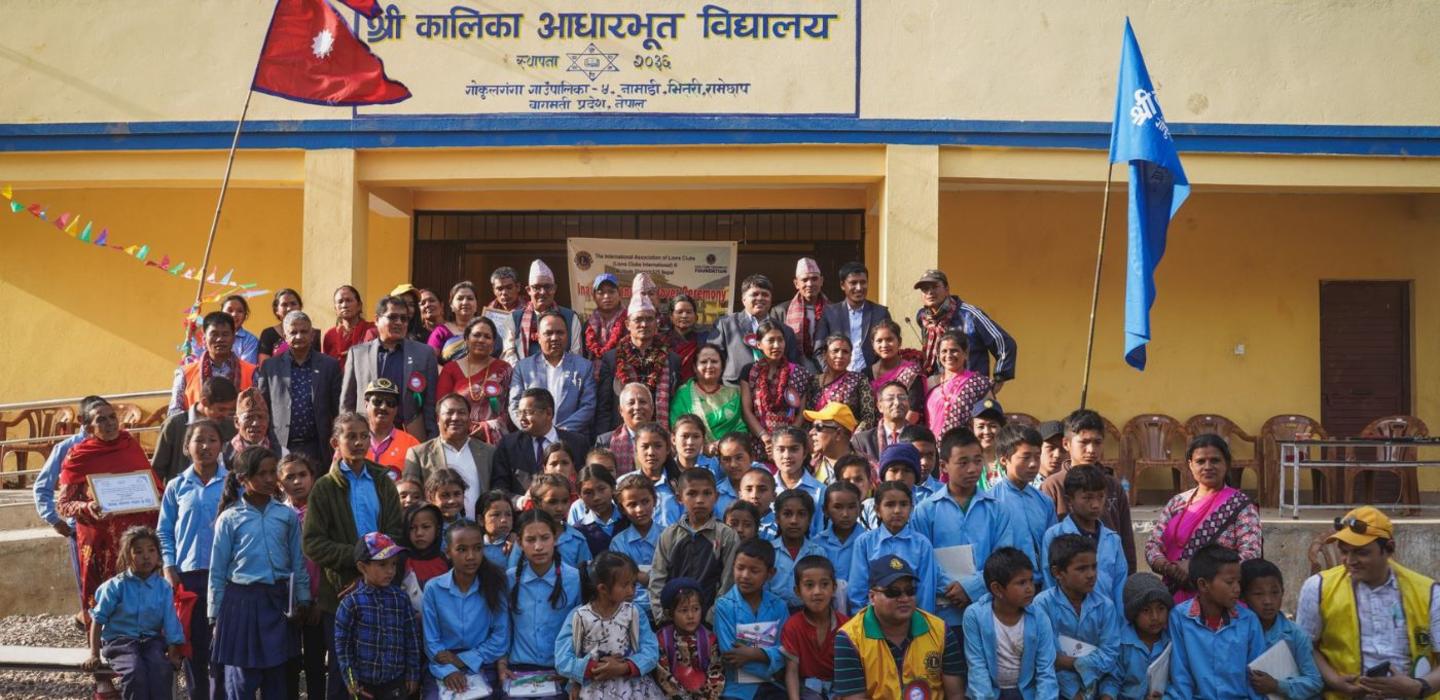On April 25, 2015, a devastating earthquake in Nepal, known as the Gorkha earthquake, took the lives of nearly 9,000 people, injured almost 23,000 and destroyed about 500,000 homes. This was Nepal’s worst natural disaster since 1934.
Lions felt that these new school buildings are not just physical structures but symbols of hope, empowering children with the means to learn, grow and realize their true potential.
Flattening entire villages, hundreds of thousands of Nepalese became homeless within minutes. Many aftershocks occurred, which led most of the population to stay outside for at least four to five nights. Then, on May 12, a massive aftershock of 7.3 moment magnitude (Mw), killed over 200 people, injured more than 2,500 and left even more people homeless. This extended disaster caused a great deal of terror within the community.
People lost everything and were living outdoors in anguish. As soon as Lions heard about this disaster, they did not hesitate to step in. Lions Clubs International Project Manager and Engineer Mikesh Shrestha explains, “The disaster brought about an unprecedented level of devastation, loss of lives and human suffering. Lions have a strong commitment to humanitarian efforts and are among the first to offer help and support when natural disasters strike.”
Shortly after the earthquake occurred, Lions Clubs International Foundation (LCIF) awarded a Major Catastrophe Grant (MCAT) of US$100,000 to MD325 Nepal for disaster relief. Lions’ leadership decided to start relief operations in the Gorkha, Dhading and Nuwakot districts; this relief then spread to other districts within two to three days. Emergency materials were sent to the epicenter of the earthquake with a helicopter, and on the return journey, the helicopter evacuated injured individuals from the village. Lions in neighboring India and Bangladesh rallied support and relief supplies to assist in the immediate aftermath of the disaster.
As the area stabilized, Lions considered new ways they could serve to rebuild what had been lost. The two earthquakes affected 39 school districts, destroying approximately 32,000 classrooms. Many schools began working in Temporary Learning Centers (TLC) that were unable to accommodate the number of students they had before the earthquake.
Most temporary classes were being held under tents, tarps and corrugated metal for extended periods of time, with very few students lucky enough to work under prefab structures. Some schools were even conducting their classes in damaged buildings or under the open sky. As a result, students were skipping classes, saying it was difficult to study in such a chaotic environment. When Lions saw the severe damage schools suffered and how this damage was impacting students, they believed they could make a significant difference. They applied for grant funding from LCIF and were awarded two Designated Grants totaling over US$4.6 million to rebuild 18 schools.
Over the next eight years, Lions worked diligently to put LCIF grant dollars to use for the benefit of students in Nepal. Shrestha says, “Through rigorous surveys of over 70 schools and campuses, we evaluated the extent of damage and urgency for each institution. This phase allowed us to narrow down our focus to the 18 schools that were in critical need and feasible for reconstruction.”
Schools play an important role in molding future leaders, and this earthquake left nearly 1.5 million children without a proper learning environment. Past Council Chairperson Girdhari Sharma Bhusal says, “Lions felt that these new school buildings are not just physical structures but symbols of hope, empowering children with the means to learn, grow and realize their true potential.” As the project chairperson of the Reconstruction Committee, Bhusal knew Lions could improve the lives of thousands of students if they just kept pushing the project forward even when they faced hardships.
Regrettably, they did face significant challenges, but they persisted for the sake of the students. According to Shrestha, “Thirteen out of the 18 school locations were quite far away and located in areas with tough landscapes and no proper road access. Materials had to be manually carried to some sites and some even became completely unreachable during the rainy season.”

Despite all the challenges faced over the years, Lions felt this project was incredibly rewarding. Bhusal says, “It was a matter of great satisfaction for all of us. As the project was carried out within the stipulated time frame in line with the design and cost estimates, it imparted greater confidence in our ability and diligence. It testified to the fact that the Nepalese Lions can act successfully in collaboration with all state and non-state stakeholders.”
Through this impactful collaboration, Lions and LCIF invested in a hopeful future for students in Nepal, offering not just classrooms, but space to encourage learning for generations to come.

Donate to LCIF’s Disaster Relief Fund to help ensure that families struggling to cope with disasters will get the support they need.
Shelby Washington is the content specialist at Lions Clubs International Foundation.

